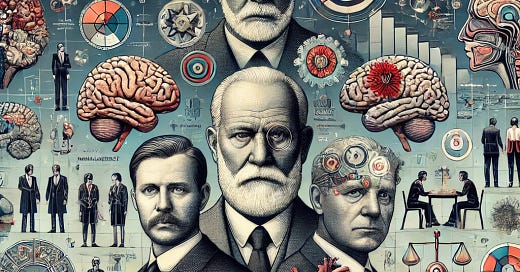The Rise of the Psychodynamic Approach in Leadership and Organisational Development
The prelude to a fall?
The psychodynamic approach, with its roots in Freudian psychoanalysis and subsequent developments, has exerted a significant influence on leadership and organisational development. This essay explores the historical and conceptual factors that contributed to the prominence of psychodynamic theories in this field. Understanding these factors provides insights into the enduring appeal and limitations of this approach in modern organisational settings and perhaps acts as a prelude to its demise.
Historical Context and Evolution
1. Freud’s Influence and the Birth of Psychoanalysis
Sigmund Freud’s pioneering work in the late 19th and early 20th centuries laid the groundwork for the psychodynamic approach. Freud’s theories on the unconscious mind, defence mechanisms, and early childhood experiences offered a revolutionary perspective on human behaviour (Freud, 1923). His emphasis on the unconscious resonated with the contemporary fascination with hidden motivations and the complexities of the human psyche. As psychoanalysis gained prominence, it extended its influence beyond clinical settings into broader areas, including leadership and organisational development.
2. Post-Freudian Developments
Following Freud, several theorists expanded and adapted psychodynamic concepts, making them more applicable to organisational contexts. Carl Jung’s theories on archetypes and the collective unconscious, Alfred Adler’s focus on inferiority complexes and social interest, and Melanie Klein’s work on object relations contributed to a richer understanding of human behaviour in group settings (Jung, 1959; Adler, 1927; Klein, 1946). These developments broadened the appeal of psychodynamic theories and made them more relevant to leadership and organisational dynamics.
Conceptual Appeal
1. Depth of Analysis
The psychodynamic approach offers a deep, nuanced analysis of human behaviour. By exploring unconscious motivations and emotional dynamics, it provides insights that go beyond surface-level observations. This depth of analysis is particularly appealing in leadership and organisational development, where understanding complex interpersonal relationships and hidden tensions is crucial (Kets de Vries, 2006). Leaders and consultants value the ability to uncover underlying issues that might not be immediately apparent through more conventional approaches.
2. Emphasis on Emotional Intelligence
Psychodynamic theories emphasise the importance of emotional intelligence, a concept that has gained considerable traction in leadership literature. Emotional intelligence involves the ability to recognise, understand, and manage one’s own emotions and those of others (Goleman, 1995). The psychodynamic focus on emotions and unconscious processes aligns well with this concept, providing a theoretical foundation for developing emotionally intelligent leaders.
3. Applicability to Leadership Styles
The psychodynamic approach provides frameworks for understanding different leadership styles and their impact on organisational culture. For example, the concept of transference—where individuals project feelings and attitudes from past relationships onto current interactions—can help explain the dynamics between leaders and their teams (Zaleznik, 1977). This understanding allows for more effective management of interpersonal relationships and enhances leadership effectiveness.
Socio-Cultural Factors
1. The Rise of Humanistic Psychology
The mid-20th century saw the rise of humanistic psychology, which shares some conceptual ground with psychodynamic theories. Humanistic psychology, with its focus on self-actualisation and personal growth, complemented the psychodynamic emphasis on understanding the whole person, including unconscious motivations (Rogers, 1961). This alignment reinforced the relevance of psychodynamic approaches in organisational contexts that increasingly valued human potential and personal development.
2. Organisational Complexity and Change
The increasing complexity and rapid change in modern organisations created a demand for approaches that could address deeper, systemic issues. Psychodynamic theories, with their focus on underlying emotional and psychological dynamics, offered tools to navigate these complexities (Hirschhorn, 1990). As organisations faced challenges related to change management, culture transformation, and leadership development, the psychodynamic approach provided a framework for addressing these issues at a deeper level.
Institutional Support and Academic Endorsement
1. Academic Endorsement
Psychodynamic theories gained traction in academic institutions, particularly in business schools and leadership development programs. Influential scholars and practitioners, such as Abraham Zaleznik and Manfred Kets de Vries, integrated psychodynamic concepts into leadership curricula and executive education programs (Zaleznik, 1977; Kets de Vries, 2006). Their work legitimised the psychodynamic approach and facilitated its adoption in organisational settings.
2. Professional Organisations and Training Programs
Professional organisations and training programs also played a role in promoting psychodynamic approaches. Institutes offering psychoanalytic training and consultancy services expanded their reach into organisational development, providing specialised programs for leaders and managers. These programs equipped organisational leaders with psychodynamic tools and techniques, further embedding the approach in leadership practice.
Conclusion
The psychodynamic approach achieved significant power in leadership and organisational development through a combination of historical influence, conceptual appeal, socio-cultural alignment, and institutional support. Its deep analysis of human behaviour, emphasis on emotional intelligence, and applicability to leadership styles provided valuable insights that resonated with leaders and consultants. Despite its limitations, the psychodynamic approach continues to offer useful perspectives for understanding and addressing the complexities of human dynamics in organisational settings.
References
Adler, A. (1927). Understanding Human Nature. New York: Greenberg.
Freud, S. (1923). The Ego and the Id. London: Hogarth Press.
Goleman, D. (1995). Emotional Intelligence: Why It Can Matter More Than IQ. New York: Bantam Books.
Hirschhorn, L. (1990). The Workplace Within: Psychodynamics of Organizational Life. Cambridge, MA: MIT Press.
Jung, C. G. (1959). The Archetypes and the Collective Unconscious. Princeton, NJ: Princeton University Press.
Kets de Vries, M. F. R. (2006). The Leadership Mystique: Leading Behavior in the Human Enterprise. London: Pearson Education.
Klein, M. (1946). Notes on Some Schizoid Mechanisms. International Journal of Psycho-Analysis, 27, 99-110.
Rogers, C. R. (1961). On Becoming a Person: A Therapist's View of Psychotherapy. Boston: Houghton Mifflin.
Zaleznik, A. (1977). Managers and Leaders: Are They Different? Harvard Business Review, 55(3), 67-78.





